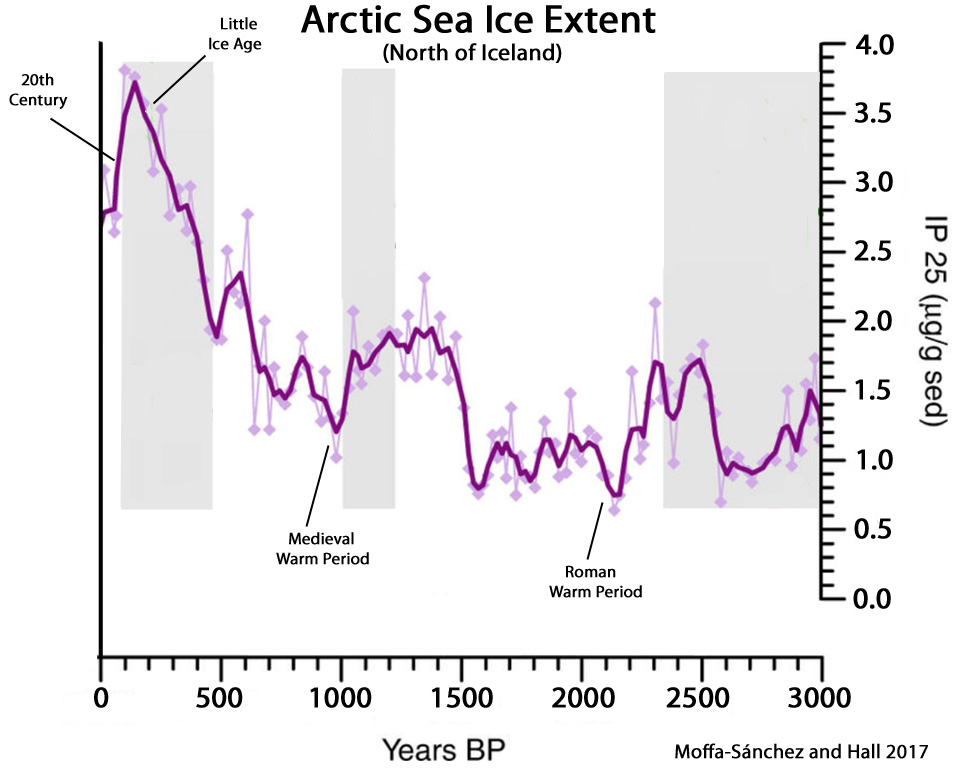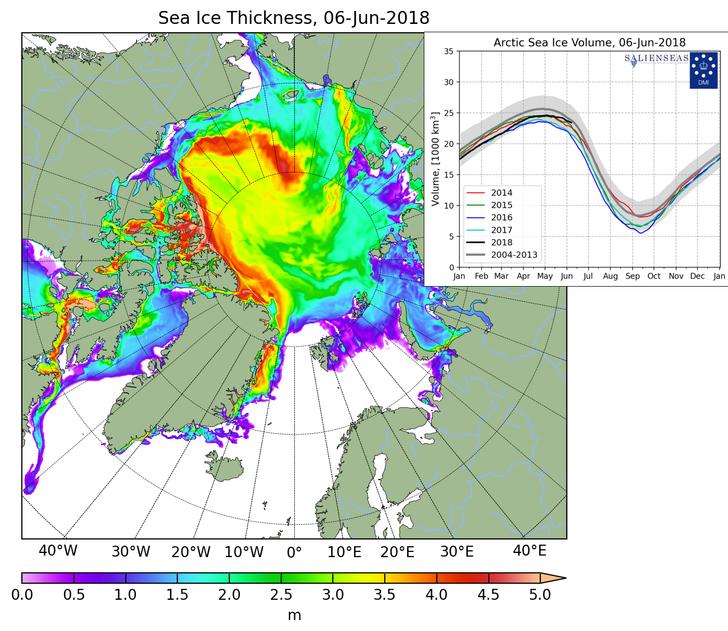AMO is not the cause of the Arctic ice decline.
What is causing Arctic sea ice decline?
 The Arctic Ocean has lost more than 30 percent of its summer ice cover in the last thirty years. Scientists have long thought that climate change is to blame, but a new study provides more evidence for that idea. Credit: Patrick Kelley, U.S. Coast Guard. High Resolution Image
The Arctic Ocean has lost more than 30 percent of its summer ice cover in the last thirty years. Scientists have long thought that climate change is to blame, but a new study provides more evidence for that idea. Credit: Patrick Kelley, U.S. Coast Guard. High Resolution Image
Readers sometimes ask us, “What are the reasons behind Arctic sea ice decline?” In summer months, ice extent has declined by more than 30 percent since the start of satellite observations in 1979. But is climate change really the culprit, or could other factors be contributing?Scientists have long suspected that the decline in summer sea ice was too strong to be caused by natural variations, such as weather patterns that cause fast changes in ice extent. Climate model simulations have shown that sea ice will decline as the Arctic gets warmer. But Arctic ice has declined faster than models predicted, raising the possibility that massive sea ice loss was caused at least in part by natural variations in weather. This month, researchers at the Max Planck Institute for Meteorology in Germany released a new study examining all the possible drivers for the observed sea ice retreat. Study lead Dirk Notz said, “There has always been the chance that we simply observed a freak encounter of unusual natural variability with very low ice cover.” Looking for a smoking gun Notz said, “The whole study was based on ruling out one possible cause after the other.” The team looked at each possible cause of ice loss, using statistical analyses to determine whether a particular cause could explain the ice decline. The scientists first considered natural variability, or the effect of short-term and seasonal weather conditions and winds. While variable winds and weather clearly play a role in how much ice melts each summer, they found that the amount of variability was far too low to explain the intensity of the decline. The researchers then looked at the possibility that ice loss was leading to more ice loss, in a vicious cycle known as a positive feedback loop. As ice declines, the increased areas of open water absorb more heat, which can then melt more ice. This is one reason that researchers are concerned about declining sea ice. However, the new study concluded that such a feedback cannot explain the amount of ice loss that has already occurred. Notz said, “After each year with an extreme ice loss, the ice cover always recovered somewhat. Self acceleration is not a major player in the Arctic at the moment.” Notz and colleagues then looked at other possible drivers for ice decline, ranging from solar radiation and cosmic rays, to volcanic eruptions, wind patterns, and oceanic heat transport. For all of these potential causes, their analysis showed that none of these were correlated with ice extent.[Which would include your AMO] “In the end, only the increase in CO2 remained on our list of possible drivers,” Notz said, “We find a clear, physically plausible correlation of increasing CO2 and decreasing sea-ice cover.” While other research has previously shown a connection between sea ice decline and global warming, most of those studies focused on climate models. The new study provides an independent confirmation that sea ice is in fact declining because of human-caused climate change. References Notz, D., and J. Marotzke. 2012. Observations reveal external driver for Arctic sea-ice retreat, Geophys. Res. Lett., 39, L08502, doi:10.1029/2012GL051094.
What is causing Arctic sea ice decline? | National Snow and Ice Data Center
What is causing Arctic sea ice decline?
 The Arctic Ocean has lost more than 30 percent of its summer ice cover in the last thirty years. Scientists have long thought that climate change is to blame, but a new study provides more evidence for that idea. Credit: Patrick Kelley, U.S. Coast Guard. High Resolution Image
The Arctic Ocean has lost more than 30 percent of its summer ice cover in the last thirty years. Scientists have long thought that climate change is to blame, but a new study provides more evidence for that idea. Credit: Patrick Kelley, U.S. Coast Guard. High Resolution ImageReaders sometimes ask us, “What are the reasons behind Arctic sea ice decline?” In summer months, ice extent has declined by more than 30 percent since the start of satellite observations in 1979. But is climate change really the culprit, or could other factors be contributing?Scientists have long suspected that the decline in summer sea ice was too strong to be caused by natural variations, such as weather patterns that cause fast changes in ice extent. Climate model simulations have shown that sea ice will decline as the Arctic gets warmer. But Arctic ice has declined faster than models predicted, raising the possibility that massive sea ice loss was caused at least in part by natural variations in weather. This month, researchers at the Max Planck Institute for Meteorology in Germany released a new study examining all the possible drivers for the observed sea ice retreat. Study lead Dirk Notz said, “There has always been the chance that we simply observed a freak encounter of unusual natural variability with very low ice cover.” Looking for a smoking gun Notz said, “The whole study was based on ruling out one possible cause after the other.” The team looked at each possible cause of ice loss, using statistical analyses to determine whether a particular cause could explain the ice decline. The scientists first considered natural variability, or the effect of short-term and seasonal weather conditions and winds. While variable winds and weather clearly play a role in how much ice melts each summer, they found that the amount of variability was far too low to explain the intensity of the decline. The researchers then looked at the possibility that ice loss was leading to more ice loss, in a vicious cycle known as a positive feedback loop. As ice declines, the increased areas of open water absorb more heat, which can then melt more ice. This is one reason that researchers are concerned about declining sea ice. However, the new study concluded that such a feedback cannot explain the amount of ice loss that has already occurred. Notz said, “After each year with an extreme ice loss, the ice cover always recovered somewhat. Self acceleration is not a major player in the Arctic at the moment.” Notz and colleagues then looked at other possible drivers for ice decline, ranging from solar radiation and cosmic rays, to volcanic eruptions, wind patterns, and oceanic heat transport. For all of these potential causes, their analysis showed that none of these were correlated with ice extent.[Which would include your AMO] “In the end, only the increase in CO2 remained on our list of possible drivers,” Notz said, “We find a clear, physically plausible correlation of increasing CO2 and decreasing sea-ice cover.” While other research has previously shown a connection between sea ice decline and global warming, most of those studies focused on climate models. The new study provides an independent confirmation that sea ice is in fact declining because of human-caused climate change. References Notz, D., and J. Marotzke. 2012. Observations reveal external driver for Arctic sea-ice retreat, Geophys. Res. Lett., 39, L08502, doi:10.1029/2012GL051094.
What is causing Arctic sea ice decline? | National Snow and Ice Data Center




 . Ok.
. Ok.



